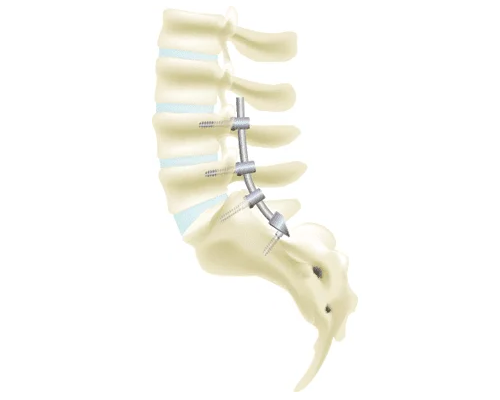Column What is Spinal Fusion Surgery? What Kind of Patients is it Indicated For? What Does it Involve? We Answer All Your Questions! (Article Supervised by a Medical Practicioner)
June 13, 2024
There are many different types of spinal disorders, such as herniated discs, spinal stenosis, and spondylolisthesis.
There are also various treatments available for each condition, but in this article, we will focus our explanations on the often-suggested spinal fusion surgery.
What is spinal fusion surgery?
Spinal fusion is a procedure in which the upper and lower spine are stabilized by fixing them together with bolts or other devices when the spine is unstable or when there is a possibility that it may have become unstable due to a previous surgery.

Indications for spinal fusion surgery
Fusion surgery is indicated for a wide range of conditions, including herniated discs, spinal stenosis, spondylolisthesis and spondylolysis, compression fractures, and scoliosis.
The literature on the subject says that there are no clear criteria for the indication of fusion surgery for lumbar degenerative disease, and that generally, fusion surgery is proposed in cases such as “(1) lumbar instability with significant pre-operative lumbar spondylolisthesis or intervertebral instability, (2) intractable low back pain of discogenic origin , (3) cases that require correction due to poor spinal balance, and (4) cases that require iatrogenic spondylolysis or facet joint resection caused by previous surgery, resulting in a decrease in post-operative spinal orientation. *1
*1 : Toshiyuki Takahashi et al. “Spinal Fusion Surgery for Degenerative Diseases of the Lumbar Spine: Indications and Methods, Including the Latest Fusion Techniques,” Journal of Neurosurgery, Vol. 24, No. 5, 2015 (in Japanese).
Spinal Fusion Surgery
Spinal fusion surgery in the lower back is performed under general anesthesia. The surgery takes between one and two hours, and consists of two different surgical techniques.
Posterior lumbar interbody fusion (PLIF)
This is a procedure in which the upper and lower spine are fixed after the herniated or collapsed disc is removed.
A skin incision is made in the back. The length of the incision varies depending on the number of vertebrae to be fixed, but it is generally 3cm or more.
The spinous processes at the back of the spine are removed, as are parts of the lamina. The disc is removed while avoiding the spinal cord. A cage made from the patient’s own bone is then inserted in place of the removed disc. Then, holes are drilled into the base of the laminae of the upper and lower vertebrae, and screws and rods are inserted and firmly secured with screws.

Transforaminal Lumbar Interbody Fusion (TLIF)
This is a procedure in which the intervertebral joint on one side is removed to widen the intervertebral foramen, and then the intervertebral disc is removed.
A skin incision is made on the back, and the facet joints on one side of the lumbar spine are removed to widen the intervertebral foramen. The intervertebral disc and bone spurs on the vertebral bodies are removed to relieve pressure on the nerves. After inserting an artificial device called a cage, the intervertebral space is fixed with screws, rods and screws.
Compared to the above-mentioned PLIF, this procedure involves less muscle stripping and less blood loss, but it is not indicated for more advanced spinal stenosis.

Benefits and risks of spinal fusion surgery
Spinal fusion is an effective operation for stabilizing the spine.
However, at the same time, it also limits drastically movement in the lower back.
It is a highly invasive procedure, and the hospital stay is quite long, involving one to two weeks.
Complications of spinal fusion surgery
・Metal screws or other objects breaking inside the body
・Paralysis due to damage to the spinal cord or nerves
・Increased stress on adjacent discs, that can cause herniation or spinal stenosis
・Risk of pus building up in the operated area.
・Nerve paralysis due to hematoma formation
・If the bones are weak due to osteoporosis, the fixed spine may collapse
For patients who are afraid of fusion surgery…
There are also many people who are afraid of having bolts or rods implanted inside their bodies.
If you would prefer a less invasive treatment, please consider our Cellgel method, Florence method, or Q-Florence method.
All 3 treatments are carried out under local anesthesia and can be performed as on-the-day procedures and do not require hospitalization.
The Cellgel Method
The Cellgel method is a treatment that repairs damaged intervertebral discs.
A drug filling the cracked part of the intervertebral disc is injected, and as it turns to a gel-like substance that fills the cracks, it prevents further degeneration of the disc and provides a fundamental treatment.
The volume of the disc is not reduced, and the drug remains in the disc as a gel-like implant after treatment, so the disc is preserved.
The Cellgel method is applicable to both lumbar disc degeneration and cervical disc degeneration.

The Florence Method
The Florence method is indicated in cases where disc degeneration is at a more advanced stage and is accompanied by conditions such as spinal canal stenosis and spondylolisthesis.
By inserting a special spacer between the spinous processes of the lumbar vertebrae, it is possible to stabilize the vertebral bodies, widen the spinal canal, and reduce the protrusion of the intervertebral disc and thickening of the ligamentum flavum, while maintaining the rotation and flexion of the spine. By widening the narrowed spinal canal, symptoms such as pain and numbness can be relieved.

The Q-Florence Method
The Q-Florence method is a minimally invasive treatment with low risk that can be used for spinal stenosis, spondylolisthesis, and lumbar instability.
A specialized device is inserted percutaneously to stabilize the unstable spine and widen the narrowed spinal canal to treat slippage.
The Q-Florence Method (in Japanese)

If you are suffering from back pain, please consider booking a consultation at our hospital.
About the author of this article

Orthopedic surgeon Tadaaki MINOWA
Academic societies / qualifications
Japanese Society for the Study of Low Back Pain
Japanese Society for Endoscopic Surgery
Certified Occupational Physician by the Japan Medical Association
Japan Cancer Treatment Certification Organization, Certified Cancer Treatment Physician
Certified doctor in the Serger method
Ozone Therapy Certified Physician
Certified doctor in the Florence method



